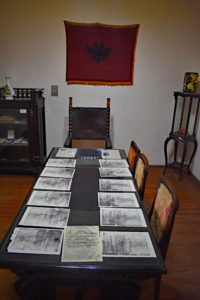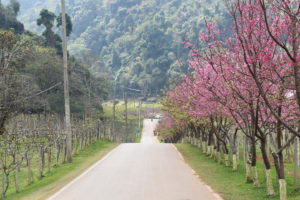The “Royal Agricultural Station”:http://www.royalprojectangkhang.com/English is, as the name implies, a project begun by King Rama IX, in northern Thailand, close to the border with Myanmar. It was established in 1969 as a research centre but also to persuade the hill-tribes to grow crops instead of opium and to settle in one place rather than their destructive practice of ‘slash, burn and move on’.
It was a 10-minute walk from our hotel, the Angkhang Nature Resort, and the entrance fee was a reasonable 50 Baht (£1.25).
At the entrance, hill tribe villagers sold organic strawberries, and there was a small gift shop and café.
Our first destination was a large hot house containing a number of plants we recognised like geranium, and fuchsia, but many we didn’t. A huge natural rock ran down one side and lush ferns abounded. There were lots of small paths and plenty of seats to sit and admire the plants.
The Highland Tropical Plants Conservatory had lots of huge green plants that grew perfectly at the altitude we were at, nearly 1500m above sea level.
The Miniature Xerophytic Conservatory was full of cacti and although I find them ugly, their weird shapes and sharp spines were fascinating. Next stop was the Bonsai garden, and whilst I’m not a fan of the miniature trees, it was hard not to be impressed.
A single-lane road runs around the station in a loop and although most of the Thai visitors drove around to the main points of interest, we walked and whilst it was a little undulating, it was an easy ramble. The information centre had large display boards in Thai, but we were able to get the gist of the project through the photographs displayed.
Half way round was the Clubhouse and Restaurant and although we didn’t want a large lunch, we found a coffee shop and sat outside in the fresh mountain air, overlooking a colourful flower garden.
Near the Clubhouse was another fabulous garden which has inspired me to grow dahlias, but sadly, the bushes in the English Rose Garden had been well pruned and it was not looking its best.
Continuing on, we passed lots of fruit trees including kiwi, pear, plum, peach, apricot and cherry which was flowering magnificently. The vegetable garden had magnificent specimens of all types of vegetables and they were trialling hydroponics and growing lettuces in water.
Back at the entrance was another colourful garden full of Thais posing amongst the flowers. By ambling round and taking our time, we found nearly 4 hours had slipped past and during this time, we’d not met another westerner.










